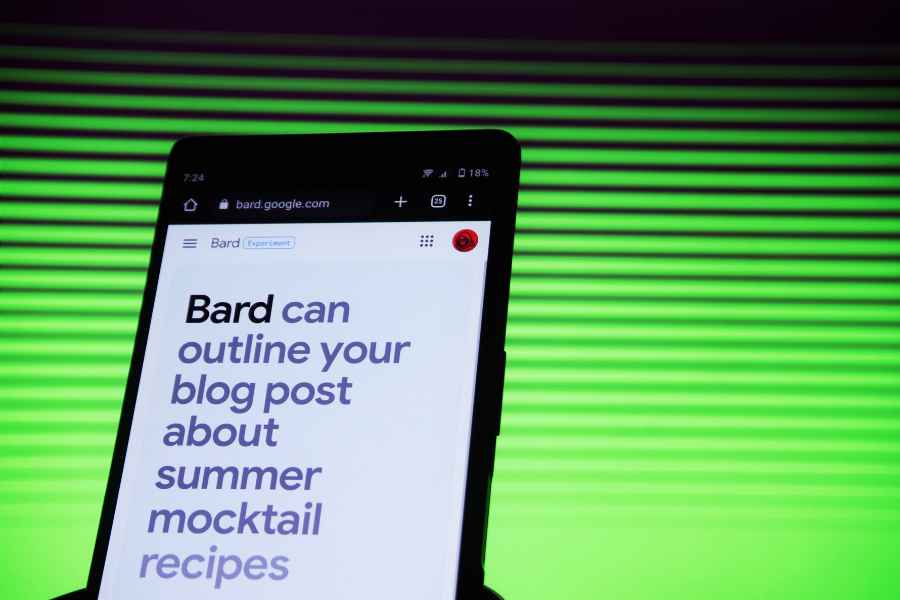Ever scratched your head thinking, “what is Google Bard?”
Don’t worry; you’re not the only one. This new AI wizardry from Google can be a bit of a puzzle at first.
But, with some guidance, you can turn that confusion into savvy know-how and unlock its full potential.
And that’s exactly what this guide is for. A deep dive into Google Brad, how to set it up, and how it compares to competitors’ AI tools.
So buckle up as it’s time to turn uncertainty into understanding!
Let’s begin.

What is Google Bard?
Google Bard AI is the newest creation from Google, a generative AI model that engages in human-like conversation.
Announced in February 2023, Bard is not just any AI; it’s a breakthrough in digital interaction. This AI tool understands context and dishes out appropriate responses, such as content creation, summarizing text, and translation work.
The name Bard, historically, refers to a poet who told stories through song. Google Bard aims to do something similar — but instead of songs, it crafts engaging, contextual responses to your queries.
Whether you are an entrepreneur crunching market data, a freelance writer seeking inspiration, or just someone looking for an intelligent digital companion, Bard can help you.
But perhaps you’re wondering how?
How Does Google Bard Work?

If you’re thinking Google Bard AI is just another form of Google search, think again.
While Google search responds with a page of links for you to click, Bard presents coherent, detailed responses, mimicking human conversation.
It digs through the trenches of the internet, comprehends the essence of the query, and delivers a conversational answer.
In other words, if you have a question like “What are the ten best books to learn art history?” Google will give you sponsored links to books, and then a list of articles posted on various other sites that are related to your question.
But if you type the same question into Google Bard, you will get a list of ten books with brief descriptions of each.
Now, who gets to use Google Bard? The answer is everyone.
Google Bard is accessible to a global audience, transcending the boundaries of language. Whether you’re an English speaker or prefer conversing in Mandarin, Bard is here to chat.
And best of all, since Google as a company makes money from advertising rather than charging the user, Google Bard is free, with no maximum query limits, anytime, anywhere.
A Basic Guide to Getting Started With Google Bard

So, you’ve decided to embark on the Google Bard journey. Where do you start?
Simple. You sign up and log in via bard.google.com, using your personal Google account. Follow any prompts that the site provides, and that’s it!
You’ve got your account.
Now, how do you actually use this thing?
Just think of Google Bard as a super-smart chatbot — you ask questions, and it provides answers.
For example, let’s say you’re a freelance writer and need information on the latest social media trends. You could simply type, “Hey Bard, can you tell me the latest social media trends for this year?” Bard will scan its knowledge base and give you an answer in real-time.
And because Google Bard uses up-to-date content sourced from Google, it can also help you with visual searches.
For instance, you could say, “Bard, find me an image of a golden sunset over a calm sea,” and voila! You have yourself a golden sunset picture.
So now that you’re in the loop go ahead, take Bard for a spin. It’s a game-changer, and it’s waiting for you to discover all the ways it can make your life easier.
How Does Google Bard Stack Up Against the Competition?

Now that you’ve got your hands on Google Bard, you might be curious to see how it stacks up against other similar AI technologies.
Let’s take a look…
Google Bard vs. ChatGPT

Now let’s compare Google Bard to another popular large language model like itself — ChatGPT.
Google Bard and ChatGPT are at the forefront of this revolution, transforming our experience from mere information retrieval to engaging, meaningful conversations.
ChatGPT, developed by OpenAI, is another conversational AI, but with a different flavor.
It’s based on the GPT (Generative Pretrained Transformer) model, which is trained on a diverse range of internet text and can generate human-like text based on the input it’s given.
But unlike many AI models, it’s designed to be more than just responsive — it’s interactive, capable of maintaining a dialogue, and can generate creative content, such as writing a blog post, a poem, or even a short story.
So while both Google Bard and ChatGPT are conversational AIs, their output and engagement style can differ based on their training and design.
Google Bard tends to be more focused on providing detailed, informational responses, while ChatGPT excels in creative thinking, able to brainstorm ideas, craft stories, and maintain complex, multi-turn conversations.
Choosing between Google Bard and ChatGPT depends on what you need from your AI conversation.
If you’re looking for a tool that provides detailed explanations and engages in more informational dialogue, Google Bard is a strong choice.
However, if you need creative insights, brainstorming assistance, or a more human-like conversational partner, ChatGPT might be the way to go.
Google Bard vs. Microsoft Bing
Next, let’s pit Bard against Bing Chat.
Bing Chat, developed by Microsoft, is a AI chatbot that offers a conversational user interface. It’s designed to interact intelligently with users, providing not only search results but also understanding the context surrounding a query.
This is achieved through the seamless integration with Bing’s search engine and the use of OpenAI’s ChatGPT language model, both enabling Bing Chat to simulate human-like conversation effectively.
A notable feature that distinguishes Bing Chat is its image creation ability.
This intriguing capability uses OpenAI’s DALL-E technology to generate images based on textual descriptions, adding an interactive and innovative dimension to the user experience.
Whereas, Google Bard does not currently offer an image creation feature.
While it helps users find relevant images efficiently, it lacks the innovative flair of Bing Chat’s ability to generate images from textual descriptions.
The accessibility of these two platforms is also worth noting. Bing Chat is integrated into Microsoft’s Edge browser, making it a perfect choice for users who prefer this browser.
Conversely, Google Bard can be accessed through Google’s vast suite of services, which might be more appealing to users heavily invested in the Google ecosystem.
The Good, the Bad, & the Future of Google Bard

Artificial intelligence is reshaping how we interact with technology, and Google Bard is a prime example of this transformation.
With its conversational approach and deep learning capabilities, Google Bard is revolutionizing the landscape of AI-powered interactions.
Let’s delve into an insightful exploration of Google Bard — its strengths, areas of improvement, and the potential it holds for the future.
The Good
- Deep Conversations: Whether you’re exploring a complex scientific theory or discussing a philosophical concept, Google Bard can understand your queries and respond in a detailed, contextual manner, making interactions feel more natural and engaging.
- Broad Knowledge Base: Trained on a vast array of text from the internet, Google Bard has a wide breadth of knowledge, making it capable of discussing a diverse range of topics. This can be especially valuable in research, learning, or brainstorming sessions.
- Contextual Understanding: Google Bard excels at understanding context, making it able to sustain conversations across multiple exchanges. This can help create a more fluid, human-like conversation experience.
The Bad
- Accuracy: While Google Bard is trained on a massive amount of information, it’s not infallible. Misinterpretations can occur, and it may occasionally provide information that’s out of date or incorrect. Always cross-verify any critical information obtained from Google Bard with other trusted sources.
- Limited Emotional Understanding: Google Bard is not as adept at understanding human emotions or subtleties in tone as an actual human. Its responses are based on patterns in data, not emotional understanding or empathy.
The Future
Looking ahead, the potential of Google Bard is immense. Here are a few directions it could take:
- Improved Accuracy: As machine learning algorithms continue to evolve, we can expect future versions of Google Bard to provide even more accurate and reliable responses, improving its effectiveness as a knowledge and discussion partner.
- Emotional Intelligence: Efforts are underway to build AI models that can better understand and respond to human emotions. Future iterations of Google Bard might be able to understand tone and emotional cues, making conversations feel even more human-like.
- Domain-Specific Expertise: Currently, Google Bard is a generalist, with a broad knowledge base. However, the future may see versions of Google Bard with specialized expertise in various domains, making it an even more useful tool for professionals and researchers.
Google Bard represents a significant stride in the world of conversational AI.
It brings a fresh and innovative approach to the interaction between humans and technology, bridging the gap between information retrieval and engaging dialogue.
And while it isn’t without its shortcomings, its potential for growth and improvement points towards a bright future in the world of AI.
Understanding its strengths, weaknesses, and potential trajectories can help us better utilize this tool and appreciate the transformative power of AI.
The Final Word on Google Bard
You’ve taken the first big leap today, understanding what Google Bard is and how it can revolutionize your world.
So go ahead, embrace the AI-power, and take your productivity to the next level. And remember, the future is not to be feared, but to be mastered.
Ready to conquer the world with Google Bard? You’ve got this!



